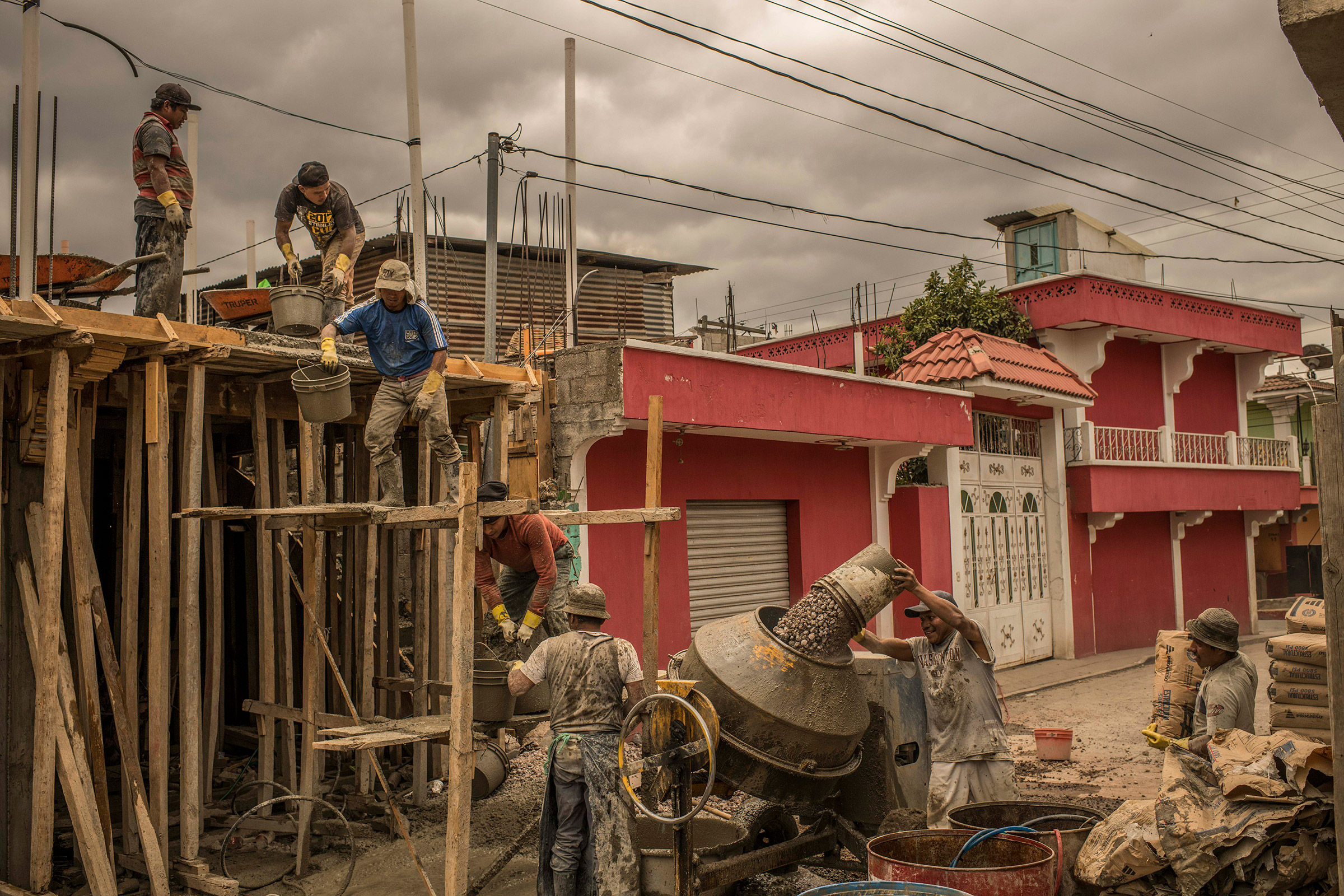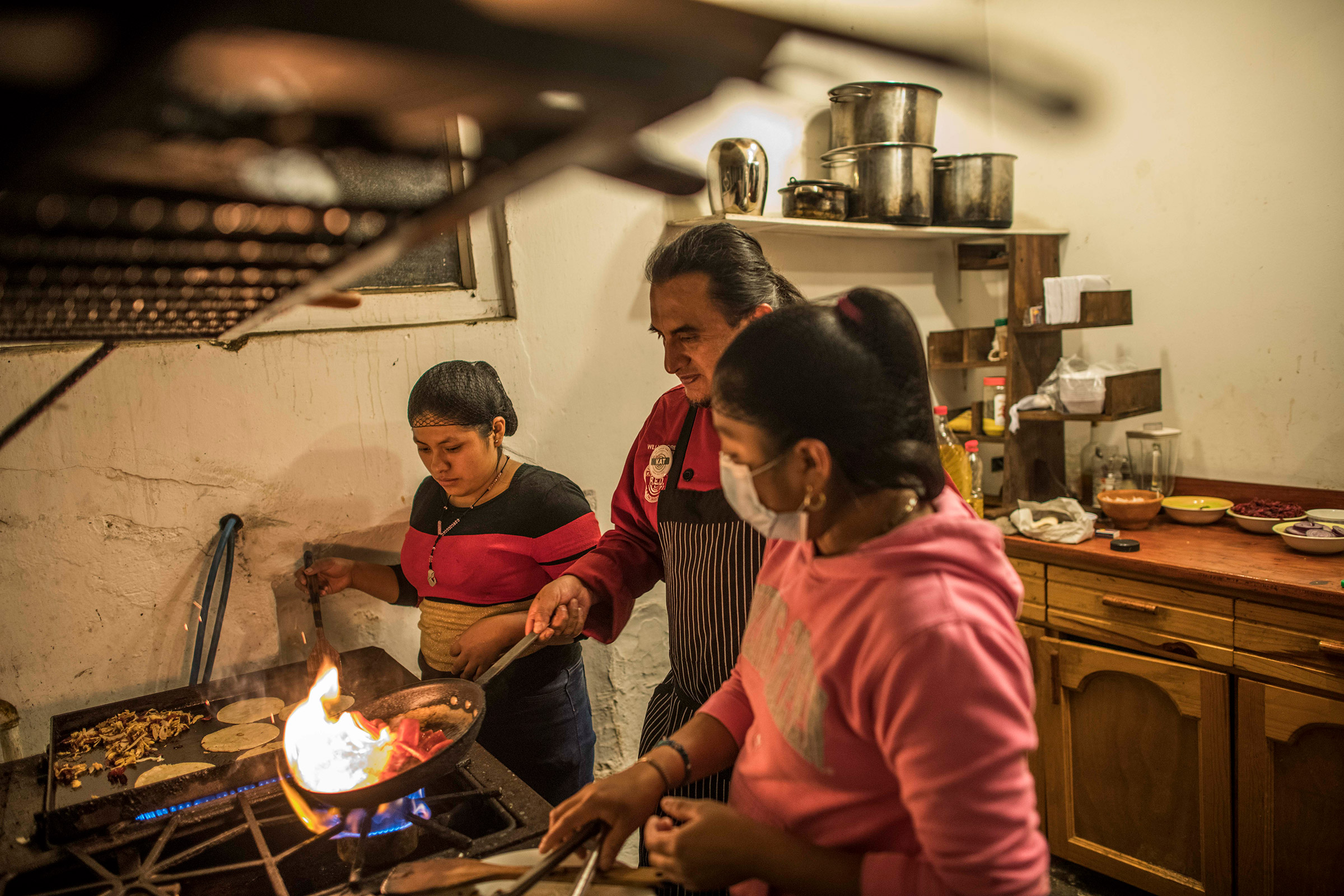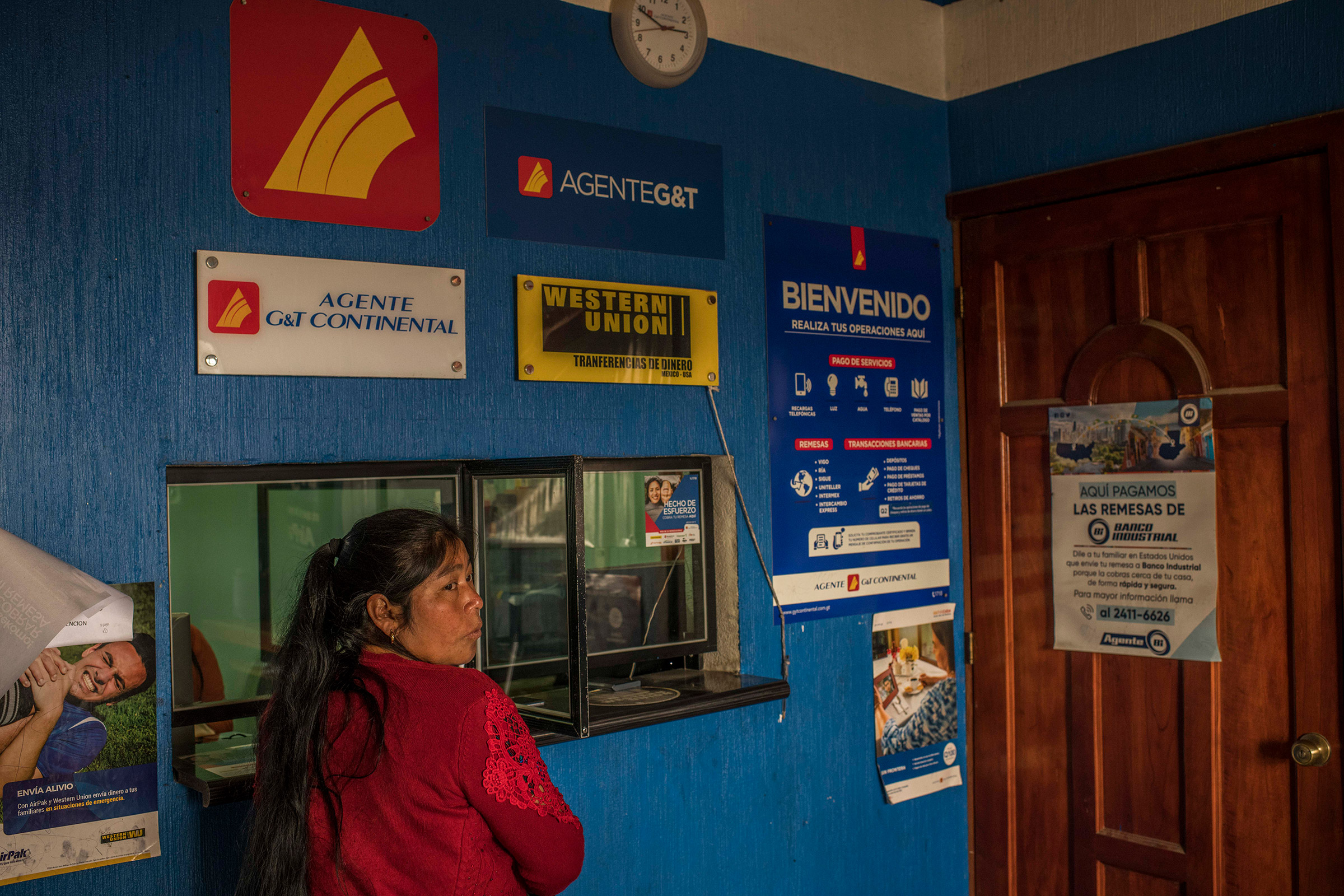
Letty Barán has an uneasy feeling when she gazes at the hills of Quetzaltenango. All around this southwestern highland region of Guatemala, which is the starting point for many of the more than 1,000 Guatemalans who leave the country every day for the U.S., elaborate houses are popping up. Three-story homes with neoclassical facades and French windows tower over their cinder-block neighbors. Dubbed “remittance architecture,” the structures are built with money sent home by migrants. And to Barán, who left the town of El Palmar in Quetzaltenango for the U.S. in 1990 and regularly returns to visit, the houses are a symbol of the trap in which Guatemala is caught.
“When I look at them, I think, first, how great that someone has been able to build their dream house. But then, how sad,” says Barán, 50.
The houses that look so much like investments actually eat cash. Built by remittances, many sit on uneven ground in areas at risk of landslides, or in places disconnected from sewers and roads. Often, the grand homes remain empty, as migrants opt to stay in the U.S. and their families prefer the comfort of their neighborhoods.
Read More: The Migration Journey to the U.S. Continues Despite Complicated Border Policy
Guatemala is losing tens of thousands of its citizens to migration annually, and 9 in 10 leave because of a lack of economic opportunity. Every year, the 3 million Guatemalans living in the U.S. send vast amounts of money home to try to improve life for their families. In 2021, buoyed by the Biden Administration’s stimulus package, remittances to Guatemala reached a record $15.3 billion—making up 17.8% of the nation’s economy (compared with 9.2% in 2011). And every year, the remittances, along with tens of millions of dollars in U.S. aid, fail to improve the situation at home. And the flow of people northward gets stronger.
The swell of migrants has stirred endless noisy debate in the U.S. But their money moves silently, largely ignored in policy and rhetoric alike.
The residents of El Palmar say changing that is key to breaking the cycle of migration. In late 2018, Barán and her son Danny, who stayed in Guatemala, joined around 30 others in setting up the country’s first migrant co-op: organizing via WhatsApp and Zoom, the members, split between people in El Palmar and their relatives in the U.S., pool a portion of their remittances together. They offer loans to members who have less cash, and share knowledge about starting businesses and building homes, enabling all of the members to launch projects that grow both members’ wealth and the local economy. “The co-ops are building a culture of savings and credit between migrants and their families, and creating a new source of leadership on development,” says Rodulfo Santizo, founder of Prima-veral Inc., a U.S.-based nonprofit helping migrants to set up remittance co-ops.

The co-op holds around 500,000 quetzales—around $65,000—and has so far invested in 10 of its members’ new businesses, including carpentry shops, bakeries, and bookstores. The aim is to eventually enlist all 29,000 of El Palmar’s residents and their relatives, to funnel as much of the money earned in the U.S. as possible into making the town a better place to live.
Read More: Title 42 is Ending in May, But These Migrants Can’t Wait That Long
El Palmar’s co-op is part of a growing movement to turn Guatemala’s unprecedented flow of remittances into lasting change for the country. Two other southern towns have set up similar mechanisms, and 13 more are in the process of doing so, according to Primaveral Inc. MayaPlus, a Guatemalan mobile-banking app launched in 2021, is reducing the fees migrants pay to send remittances to banks and giving them greater control over their funds. Such efforts are building on financial-education programs that foreign aid groups began running in Guatemala in 2016, aimed at helping remittance recipients formalize and invest their money.
The goal of these efforts is simple, says Danny, who used money sent back by his mother to start a grocery store in Quetzaltenango: “We want to improve things, to create work for everyone, so people don’t have to leave.”
Willy Barreno views his life story as a cautionary tale for Guatemala. Barreno, a former migrant, returned to Guatemala from the U.S. in 2010, with 14 years of experience cooking in restaurants from New Mexico to Chicago. Back in Quetzaltenango, he opened his own restaurant, La Red, serving Mexican dishes infused with Guatemalan flavors. He dreamed of using produce from local farmers and employing other returned migrants. But today La Red is hanging by a thread. Barreno says he relies on donations from friends and family to keep it open week to week. “This is the worst failure of my life,” he tells TIME over a Zoom call.
Barreno says businesses like his have struggled to compete with the major U.S. chains—such as Taco Bell, McDonald’s, and Domino’s—that have proliferated in Guatemala since he left in 1996. He complains that the government has failed to support the growth of domestic businesses, focusing instead on attracting foreign companies, like Walmart. Most things in Quetzaltenango come from the U.S.: the clothes in its many thrift stores, the electronics in its markets, the old cars on its streets, the money in people’s pockets.

“Remittances are like rain,” Barreno says. “Right now it’s raining a lot, but the rain comes from the sea—the U.S.—and the money all goes back there eventually. None of it stays here to develop the local economy. So none of the people want to stay either.”
The calculation for a young person considering migrating from Guatemala is stark. The average monthly minimum wage in the country is around $420, compared with almost $2,600 before tax in California. Pandemic–related business closures have made even those who were relatively well-off consider migrating, says Rosario Martinez, a researcher at the Guatemala City chapter of the Latin American Social Sciences Institute. “For a long time it was mostly poorer women from rural areas with little education who would go to work in cleaning,” she says. “Now we’re seeing professionals, people with midlevel studies or even university degrees, that because of the pandemic lost their jobs. We’re losing our youth.”
Read More: Why Are So Many Migrants Leaving Guatemala? A Crisis in the Coffee Industry
The decision to leave is not always permanent. Only one-fifth of Guatemalan migrants to the U.S. intend to move there for good, according to a 2018 survey by the Inter-American Development Bank (IDB); that’s compared with half of Salvadorans and one third of Hondurans. Most Guatemalans, migration experts say, plan to spend only a few years earning money to pay for their children’s education or help their parents build a house, and then return to a new and better life. Barán, who worked as a hotel maid in Washington, D.C., during her early years in the U.S., sent her mother money for a “small, humble” house and to invest in local businesses, which Danny now runs. Barán now lives with her other three children in Arlington, Va., and works mostly as a notary. She’s not sure if she’ll return, but if she did, she could have a comfortable life.
It doesn’t always work out that way, though. “I’ve heard so many painful stories from friends who return home after years and get the shock of their lives when they find their family has spent everything,” Barán says.
It’s not easy for migrants’ families to put aside cash. According to the IDB, remittances make up almost half of household income for those who receive them, and are crucial for covering the cost of food, clothes, and other necessities. A 2020 study by the U.N. Economic Commission for Latin America- and the Caribbean, based on surveys in a southern Guatemalan region, found that 57.1% of remittances go toward daily consumption, with 8.2% spent on building or renting homes, and only 5.4% invested or saved.
You can hardly call cash spent on daily consumption wasted. But a lack of financial education can reduce the returns that migrants and their families make on their remittances, says Rut Urizar, financial education coordinator at the Inter-American Dialogue, a think tank. Ill-fated remittance architecture is a key example, Urizar says, because saving money to build a home is often the first goal for migrants arriving in the U.S. Some recipients also lack experience handling large sums. One young mother whom the Dialogue consulted with in Huehuetenango had burnt through around $13,000 sent by her husband in a year. “She was looking after her 3-year-old daughter, and the daughter had an iPhone. And she said it’s the second phone, because the girl broke the first one,” Urizar says. “She was in tears.”
Since 2016, the Dialogue, working with partners including Cities Alliance, a U.N.-funded coalition on urban poverty; the Swiss Agency for Development and Cooperation; and the U.S. Agency for International Development, has established financial education programs in more than 30 Guatemalan towns where migration to the U.S. is common. Locals are trained as financial educators, and set up stalls inside bank branches where people go to deposit their remittances or collect wages. In 2020, the programs were responsible for formalizing $2.4 million worth of savings, and opening 3,000 financial products. They also help participants reach mortgage advisers—who will assess the value of their land—and access small-business coaches.
This kind of financial education works because it speaks to people in their language, says Jorge Mario de León, who has been consulting since 2016 out of a branch of Micoope, a savings and credit union, in Salcajá, Quetzaltenango. Sometimes that’s literal: the multilingual team offers sessions in Spanish and in local Indigenous languages like Mam and K’iche’. But educators also use their cultural knowledge of their communities to connect and drive their message home.
De León has helped people set up businesses and build homes. He also says he has persuaded some not to migrate, drawing on his own experiences with a people trafficker 22 years ago. “When I went to the U.S., it cost 35,000 quetzales [roughly $4,500]. Now it costs three times that,” he says. “So I say to people, is it worth investing that much in the journey? Why don’t you invest it in a business here? I was lost in the mountains for a month. I had to drink water from a puddle to survive. Don’t do it.”
Discussing the importance of migration and remittances to the Guatemalan economy puts the national government in an awkward position. President Alejandro Giammattei has vowed to crack down on people smugglers and reduce the exodus, in line with U.S. goals. But at the same time, as the Guatemalan daily Prensa Libre has noted, remittances are a crucial “escape valve” for millions in a country where more than half of families live in poverty. Much of Guatemala’s rapid economic growth over the past decade is due to more citizens going to the U.S. and sending money home.
“We’re talking about billions of dollars coming into the economy that the government is just kind of gifted every year,” Kathryn Klaas, then an associate at the Dialogue’s Migration, Remittances, and Development Program, told TIME in 2021. “That means that the urgency of creating sources of income that are enough for people to live on in Guatemala—which means formalizing the economy, creating a living wage for people, having regulations—that’s one agenda point that the government doesn’t have to deal with.”

The government has so far been slow to establish formal programs designed to capitalize on remittances. Its current $200 million plan to reduce undocumented migration, though heavily focused on helping to generate new businesses and jobs for people in high-migration regions, doesn’t mention the money flowing into those areas from abroad and the role it could play. Local development experts are doubtful that the plan will be more successful than previous efforts.
But officials may be waking up to remittances’ potential. Guatemala is undergoing a rapid period of urbanization, projected to take the proportion of people living in cities from 54% now—among the lowest in Latin America—to around 65% in 2030, according to U.N. estimates.
At an event organized by the Dialogue in July, Guatemala’s vice minister for housing said helping citizens manage the money from remittances to build good, well-ordered neighborhoods would be key to the nation’s development. The ministry plans to work with Guatemalan consulates to make sure migrants are using their money on “supervised projects, with some support [from the state] so they don’t end up being structurally unsound,” he said.
Many want more from the government, though, says Quique Godoy, a radio host and economist who discusses remittances once a week on his show on Guatemala’s Radio Infinita. He argues that officials should follow the example of Mexico’s government, which in the 1990s established so-called three-for-one programs: organized groups of migrants in the U.S. would fund projects in their neighborhoods back home, and for every dollar they spent, national, regional, and municipal governments would each put in $1, turbocharging the local development the migrants were leading. “We have to give incentives for migrants, so that instead of giving their money to people for consumption, they decide that they give part of it to a community investment project,” Godoy says.
Ideally, Guatemala would start a four-for-one program, supported by local businesses and banks, Godoy says. “Because that will create more consumption in the long run, which benefits business.”
But for now the migrants themselves are leading the way, says Primaveral’s Santizo. He wants to see all 340 of Guatemala’s municipalities set up credit co-ops. “We have [aid agencies] expressing interest in working with us,” he says, “but if they don’t, then we the migrants will do it ourselves. We’ll do our own development.”
—With reporting by Eloise Barry/London
More Must-Reads from TIME
- Cybersecurity Experts Are Sounding the Alarm on DOGE
- Meet the 2025 Women of the Year
- The Harsh Truth About Disability Inclusion
- Why Do More Young Adults Have Cancer?
- Colman Domingo Leads With Radical Love
- How to Get Better at Doing Things Alone
- Michelle Zauner Stares Down the Darkness
Write to Ciara Nugent at ciara.nugent@time.com